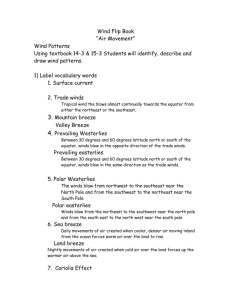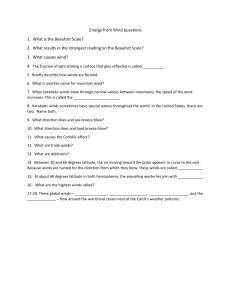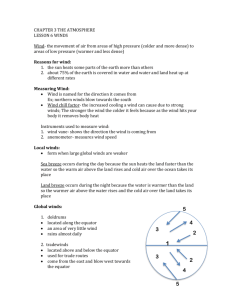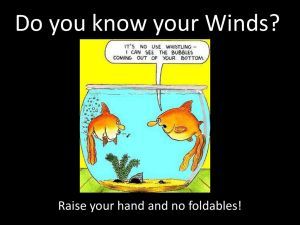Wind
advertisement
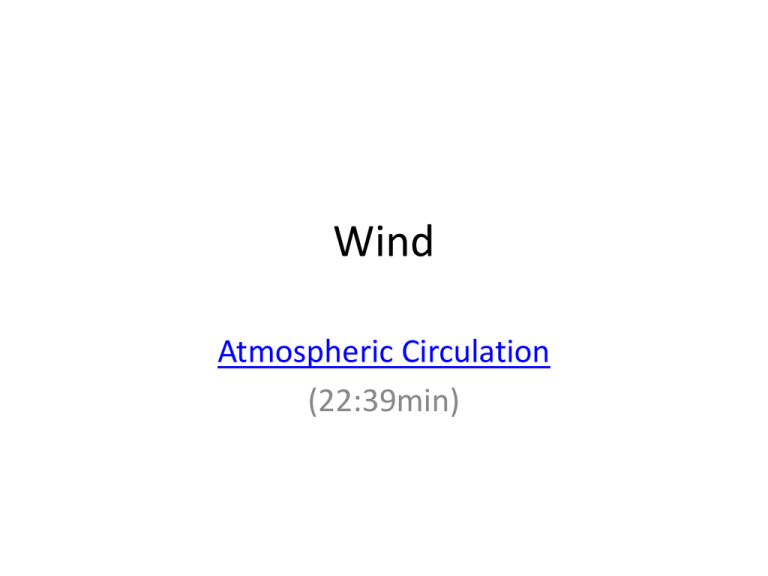
Wind Atmospheric Circulation (22:39min) Wind • The horizontal movement of air from an area of high pressure to an area of lower pressure. • Caused by the uneven heating of Earth’s surface by the sun. – Cooler, more dense air has higher air pressure and sinks. – Warm, less dense air has lower air pressure and rises. Isobar Maps • Isobar Maps show air pressure changes over an area. – The closer the isobars = higher the wind speeds. – The farther the isobars = slower the wind speeds. H L Fast Winds Slow Winds H Wind • Winds are classified by their direction and speed – Direction is described by the direction the wind is coming from. • Arrows point in the direction that the wind is blowing to. – Ex. South wind blows from the south toward the north. – Speed is measured in miles per hour (mph) or a knot (kn). • 1 knot = 1.151 mph – ½ feathers = 5 knots – Full feathers = 10 knots Determining Wind Speed & Direction Direction: From the Southeast Speed: 25 knots Wind Types • Winds are classified by how large of an area they affect. 1. Local Winds - blow over short distances. 2. Global Winds - blow steadily from specific directions over long distances. Local Winds • Blow from any direction and usually cover short distances • Causes: – The sun heats the land faster than the water. – Land loses heat faster than water. • 2 Types: – Land Breeze – Sea Breeze Land Breeze • Land Breeze – The flow of air from the land to the sea. – Occurs during the night when the land cools off faster than the sea. (Nighttime ONLY) • Convection currents drive the cooler air out over the sea. Sea Breeze • Sea Breeze – the flow of air from the sea to the land. – Occurs during the day when air over the land is warmer than the air over the sea. (Daytime ONLY) • Convection currents drive the cooler air in over the land. Global Winds • Winds that blow steadily from specific directions over long distances. – Warm air rises at the equator and cold air sinks at the poles thus producing global winds. • Due to Earth’s rotation, global winds do not follow as straight path but curve – Coriolis effect. – – – – Northern Hemisphere = curve to the right Southern Hemisphere = curve to the left Equator = doldrums, calm to no wind 30°N & S Latitude = Horse Latitudes, calm to no winds Doldrums & Horse Latitudes Northern Hemisphere Horse Latitudes Doldrums Horse Latitudes Southern Hemisphere Equator Global Wind Belts • Trade Winds – Winds that blow between the equator and 30° N and S latitude, east to west. – Belt of warm, steady wind. • Prevailing Westerlies – Winds that blow between 30° and 60° N and S latitude, west to east. – Very strong winds! • Polar Easterlies – Winds that blow between 60° N and S latitude and the poles, east to west. – Extremely cold but weak. Global Wind Belts Polar Easterlies Prevailing Westerlies Trade Winds Equator Trade Winds Prevailing Westerlies Polar Easterlies Jet Streams • Approximately 10km above Earth’s surface are bands of high-speed winds that blow from west to east. – Form at boundaries of adjacent air masses with significant differences in temperature. • 2 Types: – Polar Jet Stream – 30-60° N and S latitude • Arctic cold meets warm air mass – Strongest jet stream – Subtropical Jet Stream – 30° N and S latitude • Tropical hot meets warm air mass – Weaker jet stream Jet Streams Subtropical front


